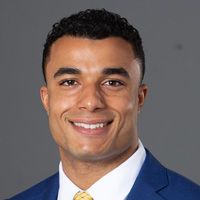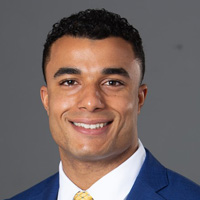You Got That New Job: Now It’s Time to Make the Right Financial Choices
Young professionals are on the move. If you’ve made a switch or have one on the horizon, follow this checklist to keep your finances on track.


Millions of Americans will start new jobs this year. With the pandemic drastically changing how, when and where we work, a fall 2020 survey by resources software company Ceridian found that sixty-four percent of all workers were actively looking or open to a new opportunity. The survey also found that a whopping 76% of workers under age 30 fell into this category.
I happen to be one of those young professionals who made a career change during the pandemic. Moving from Philadelphia to Charlotte, N.C., the opportunity to live where I want and do work that I’m passionate about was too appealing to pass up. However, as anyone who has ever started a new job knows, employment changes don’t come without challenges.
Aside from learning new responsibilities, accepting a new job also creates a laundry list of financial decisions to work through. For instance, I had to figure out what to do with my old 401(k), which health care benefits to elect, and choose between making traditional or Roth contributions into my new 401(k). Even for a financial planner, the litany of decisions can quickly become overwhelming.
From just $107.88 $24.99 for Kiplinger Personal Finance
Become a smarter, better informed investor. Subscribe from just $107.88 $24.99, plus get up to 4 Special Issues

Sign up for Kiplinger’s Free Newsletters
Profit and prosper with the best of expert advice on investing, taxes, retirement, personal finance and more - straight to your e-mail.
Profit and prosper with the best of expert advice - straight to your e-mail.
If you’re starting a new job or considering a career change, here are five recommendations that will help ensure your personal finances are taken care of and allow you to focus on mastering your new role.
Determine When Your Old Health Coverage Ends and New Coverage Begins
Some employers will cover terminated employees for the remainder of the calendar month in which they leave. For example, if your last day is June 15, coverage would remain through June 30. The new employer may allow you to be covered on your start date, but may also have another coverage start date like the 1st of the month following your start date.
Don’t get caught without coverage, even only for a few days. If possible, work with human resources at both companies to learn their policies before giving notice to your current employer so you can coordinate your coverage within COBRA guidelines. Otherwise, you may need to look into a short-term health insurance policy to bridge any gaps.
Choose the Right Health Care Benefits
With health care plans constantly changing, start by paying attention to the various deductible amounts. A great rule of thumb is to always have at least enough cash on hand to cover your highest deductible in case of emergency.
Additionally, be sure to account for the potential needs of any covered dependents. If you or a dependent has a medical condition that requires regular doctor’s visits or prescriptions, it may be worth paying for the slightly more expensive option.
You’ll also want to give careful consideration to optional life insurance or long-term disability coverage. One of the biggest and most often neglected risks for young professionals is losing your ability to earn an income over the coming decades. Protecting yourself and your loved ones with disability insurance is almost always the financially responsible choice.
Lastly, if you choose a high deductible health plan (HDHP), enroll in a health savings account (HSA). HSAs receive what is known as “triple tax-advantaged” treatment, meaning contributions are tax deductible when they’re made, funds can be invested on a tax-deferred basis, and distributions are income-tax free if used to pay for qualified medical expenses. Note that the IRS requires individuals to be covered by a HDHP to be eligible to contribute to an HSA.
Your employer may even make HSA contributions on your behalf if you participate in certain wellness activities, such as health screenings, so be sure to inquire about how you can potentially qualify for free money.
Know Your Old Employer’s Policy on Vacation Payout
Many companies will pay departing employees for unused vacation days. In my case, I had nearly 25 days of unused vacation when I left my last job, for which I received more than $5,000 in addition to my final paycheck. Even if you only have a few days accrued, I strongly recommend contacting your HR representative prior to your last day to inquire about your vacation balance, the amount you’re entitled to as your payout, and when you can expect to receive it.
Conversely, be aware the opposite can be true if you have previously used vacation time that has not yet been accrued. In these instances, you’ll likely be obligated to pay the company back via a reduction from your last paycheck (assuming your paycheck covers the amount owed).
Enroll in Your New Employer’s 401(k) Retirement Plan
Find out when you can enroll in the new employer’s plan and do so as soon as you’re eligible. Despite many companies adopting automatic enrollment policies, don’t rely on this alone. Many such programs automatically enroll new hires at fairly modest contribution rates, such as 3% or 5% of pay, which can serve as a starting point, but will not be enough to achieve retirement and financial independence goals for most individuals.
Many financial experts agree that saving 15% between your employer’s retirement plan and other retirement accounts is sufficient; however, I believe 20%-25% is ideal. Even if that’s not feasible just yet, it’s crucial that you contribute at least the amount required to receive your full employer match. Yet another plug for free money!
It’s also worth noting that people in lower tax brackets – at or below roughly 25%, including federal and state taxes – might consider making Roth contributions if their 401(k) plan permits them. Unlike “traditional” or pre-tax contributions, Roth contributions are made with after-tax money, which then grow tax-deferred and allow for tax-free distributions in retirement.
Finally, don’t forget to select your investments. For the majority of young professionals, a target date retirement fund can be a solid option. Just pick the retirement year that aligns with your goals, set it and forget it.
Roll Over Your Old 401(k) Account
Many young professionals have tens of thousands of dollars in their former employers’ 401(k) plans. Don’t let these accounts sit idle for long – they’re easy to forget about and much more difficult to manage when your money is in numerous places. Like many of my friends, I avoided rolling over my 401(k) for over a year after leaving my first job out of fear that it would be stressful and time-consuming. Much to my pleasant surprise, it took less than 20 minutes to fill out a few simple forms, initiate the transfer, and have my money invested within a couple business days.
One rollover method you might consider is rolling the money from the old account into your new 401(k), if your new plan allows incoming rollovers. Most 401(k) providers offer online account access and provide step-by-step instructions on the rollover process. It’s really not as scary as it sounds – just be sure to elect a “Direct Rollover” and not a distribution.
Your other option would be to roll the money into a new or existing IRA. Opening a rollover IRA is easy and can be done through an online brokerage firm in a matter of minutes.
Last, and most importantly, do not cash out these accounts. Regardless of the amount, cashing out will result in unnecessary taxes, penalties, and ultimately robbing your future self of a more enjoyable retirement.
Starting a new job is an exciting time, full of hope and opportunity. By making the right financial decisions, you can enjoy a fulfilling career while also building substantial personal wealth. Take time during those first few weeks on the job to study your options, put a strategy in place, and set yourself up for long-term financial success.
Profit and prosper with the best of Kiplinger's advice on investing, taxes, retirement, personal finance and much more. Delivered daily. Enter your email in the box and click Sign Me Up.

As an Associate Wealth Adviser at CI Brightworth, Jalen P. Randolph is passionate about helping high-earning professionals maximize their unique wealth-building opportunities through personal planning and advice. Prior to joining CI Brightworth, Jalen worked in both financial services and non-profit development. He earned his bachelor of science and master's of business administration degrees from the University of Delaware.
-
 The Stoic Retirement: Ancient Wisdom for Today's Reality
The Stoic Retirement: Ancient Wisdom for Today's RealityA "Stoic retirement" doesn't mean depriving yourself. It's a character-based approach to life and aging that can bring calm and clarity.
-
 My Teen Crashed His Car and Now Our Insurance Has Tripled. What Now?
My Teen Crashed His Car and Now Our Insurance Has Tripled. What Now?Dealing with the costly aftermath of a teen car accident is stressful. Here are your options for navigating it.
-
 11 Outrageous Ways To Spend Money in Retirement
11 Outrageous Ways To Spend Money in RetirementWhether you have excess cash to spend or want to pretend, here’s a look at 11 ridiculous ways retirees can splurge.
-
 I'm a Financial Planner for Millionaires: Here's How to Give Your Kids Cash Gifts Without Triggering IRS Paperwork
I'm a Financial Planner for Millionaires: Here's How to Give Your Kids Cash Gifts Without Triggering IRS PaperworkMost people can gift large sums without paying tax or filing a return, especially by structuring gifts across two tax years or splitting gifts with a spouse.
-
 'Boomer Candy' Investments Might Seem Sweet, But They Can Have a Sour Aftertaste
'Boomer Candy' Investments Might Seem Sweet, But They Can Have a Sour AftertasteProducts such as index annuities, structured notes and buffered ETFs might seem appealing, but sometimes they can rob you of flexibility and trap your capital.
-
 Quick Question: Are You Planning for a 20-Year Retirement or a 30-Year Retirement?
Quick Question: Are You Planning for a 20-Year Retirement or a 30-Year Retirement?You probably should be planning for a much longer retirement than you are. To avoid running out of retirement savings, you really need to make a plan.
-
 Don't Get Caught by the Medicare Tax Torpedo: A Retirement Expert's Tips to Steer Clear
Don't Get Caught by the Medicare Tax Torpedo: A Retirement Expert's Tips to Steer ClearBetter beware, because if you go even $1 over an important income threshold, your Medicare premiums could rise exponentially due to IRMAA surcharges.
-
 I'm an Insurance Pro: Going Without Life Insurance Is Like Driving Without a Seat Belt Because You Don't Plan to Crash
I'm an Insurance Pro: Going Without Life Insurance Is Like Driving Without a Seat Belt Because You Don't Plan to CrashLife insurance is that boring-but-crucial thing you really need to get now so that your family doesn't have to launch a GoFundMe when you're gone.
-
 I'm a Tax Attorney: These Are the Year-End Tax Moves You Can't Afford to Miss
I'm a Tax Attorney: These Are the Year-End Tax Moves You Can't Afford to MissDon't miss out on this prime time to maximize contributions to your retirement accounts, do Roth conversions and capture investment gains.
-
 I'm an Investment Adviser: This Is the Tax Diversification Strategy You Need for Your Retirement Income
I'm an Investment Adviser: This Is the Tax Diversification Strategy You Need for Your Retirement IncomeSpreading savings across three "tax buckets" — pretax, Roth and taxable — can help give retirees the flexibility to control when and how much taxes they pay.
-
 Could an Annuity Be Your Retirement Safety Net? 4 Key Considerations
Could an Annuity Be Your Retirement Safety Net? 4 Key ConsiderationsMore people are considering annuities to achieve tax-deferred growth and guaranteed income, but deciding if they are right for you depends on these key factors.